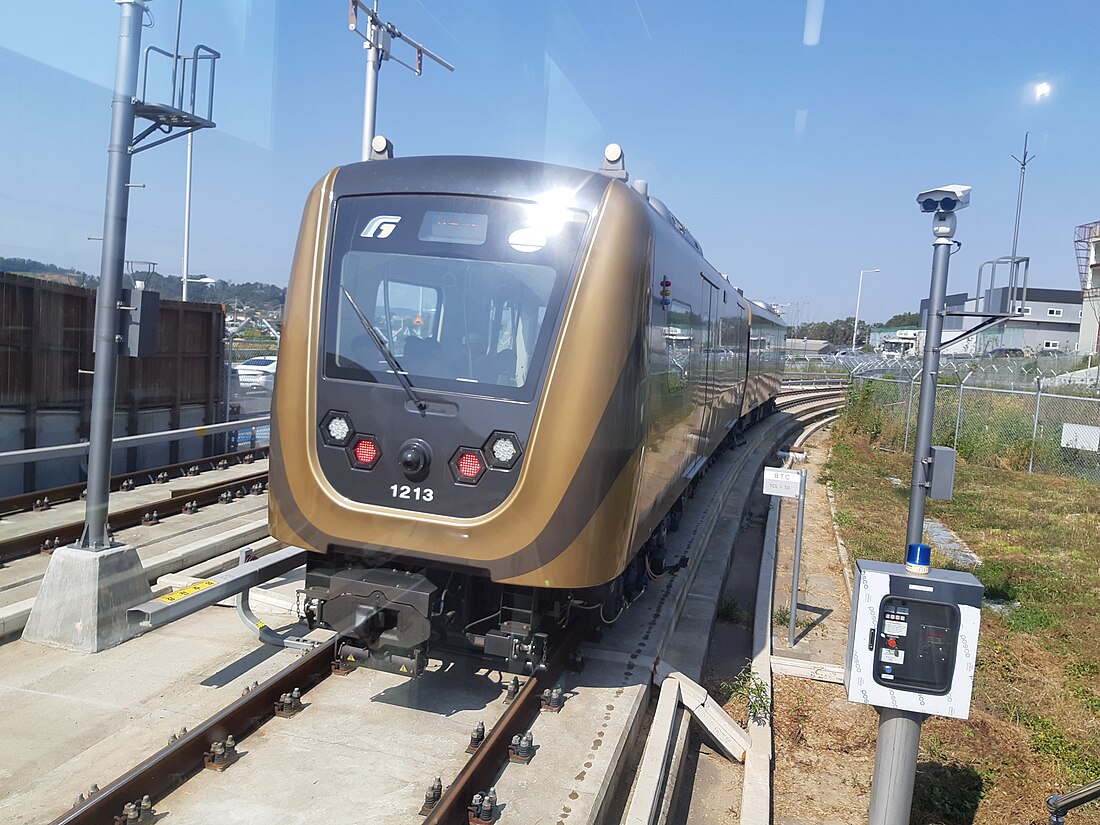Top Qs
Timeline
Chat
Perspective
Gimpo Goldline
Light rail line in Gyeonggi-do and Seoul, South Korea From Wikipedia, the free encyclopedia
Remove ads
The Gimpo Goldline (Korean: 김포골드라인 or Korean: 김포 도시철도; Hanja: 金浦都市鐵道) is a light metro line opened on 28 September 2019.[1]
You can help expand this article with text translated from the corresponding article in Korean. (April 2022) Click [show] for important translation instructions.
|
This article needs additional citations for verification. (November 2021) |
Remove ads
Background
Summarize
Perspective
Under the third mayor of Gimpo City, Kim Dongsik (김동식), the line was going to be an extension of Line 5. This idea was rejected by Seoul Metropolitan Rapid Transit Corporation (now Seoul Metro) as they wanted to build a subway yard in the town of Yangchon-eup.
Since then, the Gimpo Han River Metro project was promoted under the mayor of Kang Kyung-gu, but the plan was canceled and Seoul Subway Line 9 extended to Gimpo but failed after Yoo Young-rok, a Democrat who was at a political crossroads with Kim Dong-sik and Kang Kyung-gu's Grand National Party, was elected. The opening of the metro has been delayed several times under the current mayor, Yoo Young-rok and Chung ha-yeong, and it has been criticized by citizens.
The construction cost was ₩1.6503 trillion with ₩1.2 trillion from Korea Land and Housing Corporation. The funds came from the wide-area transportation contributions paid to the company by residents of the Hangang New Town. Two-car vehicle operates at intervals of three minutes during peak hours with a maximum occupancy of 122 people per car. The line uses rolling stock by Hyundai Rotem. Travel time from one end to the other is an estimated 30 minutes and transfers are available at Gimpo International Airport station. In 2012, planners expected 88,257 passengers during the first year of operation (then 2018), 91,501 in 2021, and 92,561 in 2026 with an operating deficit of roughly ₩10 billion.[3]
Remove ads
Operation
Since its design, Gimpo Gold Line has two train compartments that can be used underground. Therefore, it operates as a single train with two compartments.[4]
As people commuting to and from Seoul rush to work and get off work, the level of congestion is enormous, showing the end of the 'hell subway'.[5]
Stations
| Station Number |
Station Name English |
Station Name Hangul |
Station Name Hanja |
Transfer | Distance in km |
Total Distance |
Location | |
| G100 | Yangchon (Dawon City) |
양촌 (다원시티) |
陽村 | --- | 0.0 | Gyeonggi-do | Gimpo-si | |
| G101 | Gurae | 구래 | 九來 | 1.37 | 1.37 | |||
| G102 | Masan | 마산 | 麻山 | 1.17 | 2.54 | |||
| G103 | Janggi | 장기 | 場基 | 2.29 | 5.53 | |||
| G104 | Unyang | 운양 | 雲陽 | 1.69 | 7.22 | |||
| G105 | Geolpo Bukbyeon | 걸포북변 | 傑浦北邊 | 3.39 | 10.61 | |||
| G106 | Sau (Gimpo City Hall) |
사우 (김포시청) |
沙隅 | 1.87 | 12.48 | |||
| G107 | Pungmu | 풍무 | 豊舞 | 1.38 | 13.86 | |||
| G108 | Gochon | 고촌 | 高村 | 3.69 | 17.55 | |||
| G109 | Gimpo Int'l Airport | 김포공항 | 金浦空港 | 5.92 | 23.47 | Seoul | Gangseo-gu | |
References
External links
Wikiwand - on
Seamless Wikipedia browsing. On steroids.
Remove ads




